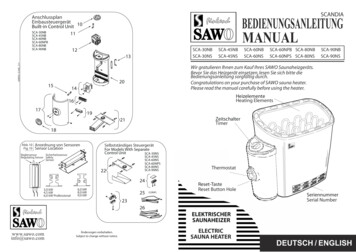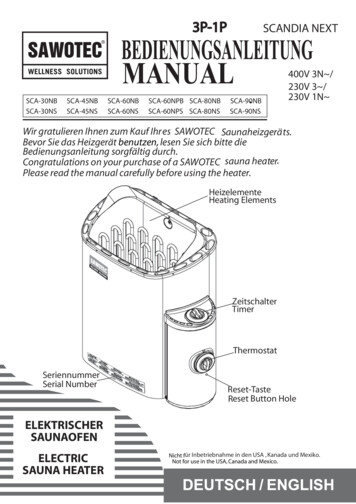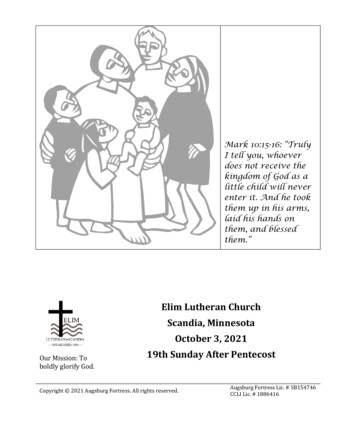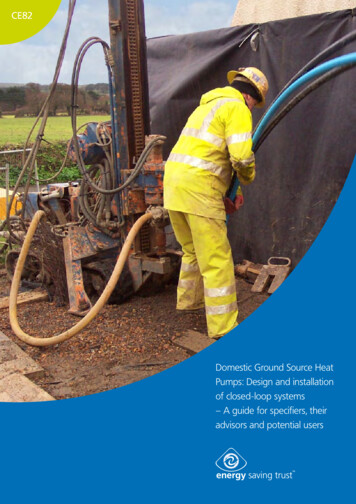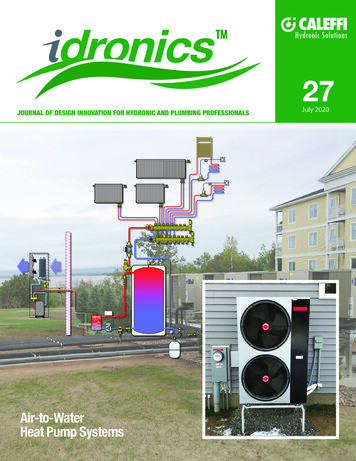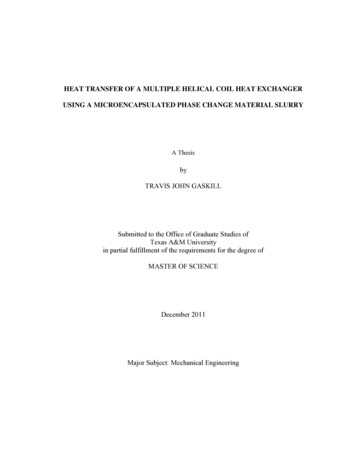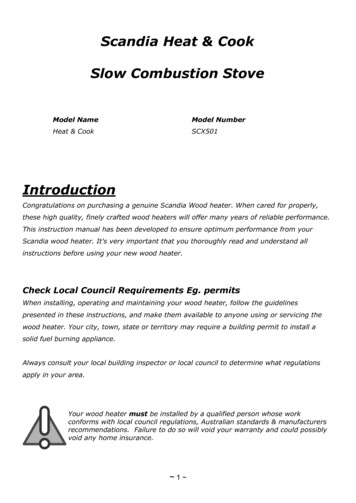
Transcription
Scandia Heat & CookSlow Combustion StoveModel NameModel NumberHeat & CookSCX501IntroductionCongratulations on purchasing a genuine Scandia Wood heater. When cared for properly,these high quality, finely crafted wood heaters will offer many years of reliable performance.This instruction manual has been developed to ensure optimum performance from yourScandia wood heater. It's very important that you thoroughly read and understand allinstructions before using your new wood heater.Check Local Council Requirements Eg. permitsWhen installing, operating and maintaining your wood heater, follow the guidelinespresented in these instructions, and make them available to anyone using or servicing thewood heater. Your city, town, state or territory may require a building permit to install asolid fuel burning appliance.Always consult your local building inspector or local council to determine what regulationsapply in your area.Your wood heater must be installed by a qualified person whose workconforms with local council regulations, Australian standards & manufacturersrecommendations. Failure to do so will void your warranty and could possiblyvoid any home insurance. 1
Wood Heater SafetyWhen properly maintained and operated your wood heater should give you many years ofservice, however there are important safety aspects of these products that you need to beaware of when operating a wood heater.1.This appliance is not intended for use by persons (including children) with reducedphysical, sensory or mental capabilities, or lack of experience and knowledge, unlessthey have been given supervision or instruction concerning use of the appliance by aperson responsible for their safety.2.Children should be supervised to ensure that they do not play with the appliance.3.If the electrical supply cord is damaged, it must be replaced by the manufacturer, itsservice agent or similarly qualified persons in order to avoid hazard.4.Never place combustible items such as but not limited to furniture, fabric or woodwithin the specified clearances to combustibles.5.The burning of wood gives off gases which can be extremely dangerous. Wood heatersare designed so that under normal operating circumstances these gases pass up theflue chimney system and cannot escape into your home, however it is important thatyour flue system is properly installed and that you check all joints regularly to ensurethat there are no cracks or gaps, check the door sealing rope and replace whendamaged. We recommend a smoke alarm be fitted in rooms where wood heaters areinstalled. Do not use wood heater in a room where negative pressure conditions mayoccur, such as through the use of extraction fans unless an adequate air supply into theroom is ensured, as this may draw air through the wood heater and cause products ofcombustion to escape into the room.6.This appliance is designed to specifically burn dry hardwood. Do not burn rubbish,driftwood, flammable liquids or any substance containing salts or corrosives.7.Creosote and soot may accumulate in your flue pipe and chimney. This may ignite,causing a chimney fire. If you suspect a chimney fire close down the air controls on thewood heater, if the fire persists evacuate people from the building and call the FireBrigade. To prevent the accumulation of soot or creosote, check flue and chimneyregularly and clean as necessary. Good burning, hot wood heaters will generally causea lot less build-up than slow burning wood heaters, likewise dry wood will cause lessbuild-up than wet wood. We recommend a fire extinguisher be available where woodheaters are in operation. In the event of a chimney fire do not re-light the wood heateruntil it and the flue chimney system have been thoroughly checked and repaired asnecessary.8.Wood heaters get extremely hot and should not be touched when lit. When youngchildren are in the area, we recommend the use of a suitable fire guard around thewood heaters. Always wear protective gloves when reloading wood heater.9.Never over-fire your wood heater. If external parts of your wood heater are glowing redthen the wood heater is over-firing and your draught settings should be reduced. Neverinterfere with the draught mechanisms or adjust your air settings outside those limitsset when the wood heater is manufactured. Never use a fan to supply air to the woodheater or to extract air from it.10. All users of the wood heater should be aware of the contents of this manual. Pleaseleave this manual where it is accessible to wood heater users and do not allow anyoneto use the wood heater that is unfamiliar with its correct operation.11. Never use the wood heater if any parts are missing or damaged, only use genuine partsas replacements. Never modify your wood heater. 2
Before Installing your wood heaterYou need to consider the following to ensure the safe operation of your wood heater.Provision of adequate air to support efficient combustion of the fuel.A well sealed flue/chimney system, hereinafter referred to as the “flue system”.The protection of combustible materials in proximity of the wood heater.A suitable base on which to place your wood heater.Adequate provision airIt is essential for the safe and efficient use of your wood heater that you provide anadequate air supply to your wood heater. This may mean the provision of an outside airsupply to the room, especially if there are extraction units such as cooker hoods or clothesdryers in the vicinity. Failure to do so will mean that fuel is burned inefficiently causingsmoke and blackening the glass and may also cause smoke to come back into the room. Asa simple check for this open a door or window in the room and check if the wood heaterburns more efficiently.Well sealed flue systemUnder no circumstances should you use aluminum or galvanized steel pipes for your woodheater flue.Always fit pipes with the narrow crimped side down, this allows any creosote to run downthe inside of the pipe and not to come out and cause an unsightly mess and possible firehazard.Pipe bends should be kept to a minimum and we do not recommend using more than 2bends on any installation. Flues must not pass through ceilings, floors, attics, roofs, orcombustible walls without adequate and approved insulation being provided to protectcombustible materials.The chimney and flue provide a means of taking combusted fuel from the wood heater, aswell as a draught to enable the wood heater to work. It is essential that the flue system iskept in good condition and there are no breaks or cracks allowing contact with any othercombustible materials of the house. It is also essential that the flue system is kept clean andseals are maintained to ensure the draught is not lost.The open end of the flue system must be above the height of the apex of the building andany other obstructions, such as trees, which are within 3 meters (10ft) of the flue system.Failure to do this will affect the efficiency of the wood heater and may cause down draughtswhich will mean dangerous products of combustion are emitted into room.Under no circumstances should the flue pipe be less than 6” (152mm) internal diameter.Clearances to combustiblesIt is extremely important that you respect required installation distances and that yourespect local installation regulations. This is for your safety! The manufacturer is notresponsible for the product, if it is not installed following these recommendations. Theseclearances may only be reduced by means approved by the regulatory authority. Cont. 3
A combustible surface is anything that can burn (i.e. plaster, wall paper, wood, fabrics etc.)These surfaces are not limited to those that are visible and also include materials that arebehind non-combustible materials. If you are not sure of the combustible nature of amaterial, consult your local fire officials.Hearth requirementsThe floor protector must consist of 30.0mm thick cement fibre sheet which has a thermalresistance of 0.8m2 K/W, per 4mm thickness or equivalent. Scandia have a complete rangeof suitable ready to install hearth pads for straight wall and corner installations.InstallationWarmbrite Clearances to CombustiblesParallel InstallationCorner InstallationACCHBFFDDEEGGSCX501A – Rear of heater to rear wall175mm*B – Side of heater to side wall425mmC – Rear corner of heater to wall200mm*D – Hearth to door hinge200mmE – Front of heater to hearth front300mmF – Minimum hearth depth900mmG – Minimum hearth width820mmH – Rear of heater to centre of spigot112mm*with decorative flue, with at least 180 heat shield and 900mm 180 flue shield in place. 4
For connecting into a standard installation using Scandia DefaultFlue Kits:The following drawing is meant as a guide only. Your wood heater must be installed by aqualified person whose work conforms with local council regulations, Australian/New Zealandstandards (AS/NZS 2918:2001) & manufacturers recommendations.1. Locate wood fire in its proposed position according to manufacturers recommendations.2. Use a plumb bob to mark the ceiling in line with the centre of the flue collar.3. Check that the outer casing will clear all combustible materials by 25mm. Determinepositions of noggins to avoid cutting, otherwise headers must be installed for strength.4. Cut a 305mm diameter hole in the ceiling. Directly above cut a hole in the roof toaccommodate outer casing.5. Fix the angle brackets to the joists so that the drop box (first length of located casing) islocated in the centre of the hole. 5
6.Position the drop box between the angle brackets, keeping a 25mm clearance tocombustibles. The located end of the drop box must protrude no less than 150mmdown from the ceiling. Fix the drop box to the angle brackets.7.Add the remaining casings to the required height. Australian/New Zealand Standardsstate that “the flue pipe shall extend not less than 4.6m above the top of the floorprotector”. If the flue pipe is within 3 metres of the ridge, the flue pipe must protrudeat least 600mm above the ridge of the roof. If the distance from the ridge is more than3 metres, the flue pipe must protrude at least 1000mm above roof penetration.Additional lengths of casing and flue may be required to achieve this. The flue pipemust be more than 3 metres from any nearby structure. Other clearances may beapplicable, it is up to the installer to ensure compliance with all regulations.8.Install roof flashing (optional accessory).9.Secure the Ceiling Collar in place using ceramic spacers and screws provided.10. Insert crimped end of the upper decorative flue (without internal stainless steel heatshield) up into the drop box. Then insert the crimped end of the lower decorative flue(with the internal stainless steel heat shield) up into bottom of the upper decorativeflue. The lower decorative flue features locating tags on the non crimped end whichrest on the heater flue collar. The solid heat shield section of the decorative mesh andstainless steel inner heat shield is to face the wall.11. Feed stainless steel flue through decorative flue and drop box through to the requiredheight. Assemble flue pipes tight together as you go ensuring seams are straight.Secure each joint with three stainless steel rivets spaced equally. Clean any fingerprints or oils off stainless steel flue with methylated spirits.12. Trim the inner flue to the same height as the outer casing. Place cover cone and cowlover stainless steel flue & push cover cone over gal casing. Fix with stainless steel poprivets.For connecting into existing masonry chimney:The Chimney should be swept prior to installation. The Chimney must not have any hollowsections present. The connecting flue pipe must be sealed to the chimney with fire cementand high temperature resistant rope as required. This is usually done into a register(Blanking) plate with an access door/hatch to enable chimney sweeping. Flue pipe mustcontinue for the full length of the chimney. The top must be suitably weather sealed with achimney to flue pipe adaptor sealed in place with mortar. The flue must be completed with acowl. Note there should not be any flue exposed to the elements. 6
Operating Your Wood HeaterFuelYour wood heater is designed to burn dry hardwood only.; it is not designed to burn, Soft wood Paper or cardboard, other than small amounts used to light stove. Treated or painted wood Synthetic fuel or logs that are not approved for solid fuel stoves Household rubbish Liquid fuels PlasticsBurning these or other products for which the wood heater was not designed may damagethe wood heater and cause a fire hazard or release toxic fumes.Fuel should be stored in a dry place; wood should be dried for at least 1 year and have amoisture content of no more than 20%. Wet wood may cause serious creosote, which maydamage your flue system and even your wood heater. Therefore the use of wet wood isstrongly discouraged.Controls and their use11. Flue Damper - Aids in lighting fire. Back Open,Forward Closed.22. Primary Air Inlet Control - Provides primary airintake to regulate burn rate of fire and keep glassclean.3. Secondary Air Inlet Control - Provides secondaryair intake directly to coal base to further regulate burnrate of fire.34. Oven Temperature Control - Provides cool air tooven to further regulate oven temperature. (Burn rateof fire will be the main temperature regulation).4First operation of stoveWarning: When operating, this unit will get extremely hot. Do Not Touch, use tools wherenecessary.You should begin using your wood heater by lighting small fires which get progressivelylarger. We recommend lighting approximately 5 small fires before you put the wood heaterinto full service. Allow the wood heater to fully cool between each of these fires. There maybe some smell and a small amount of smoke from the wood heater during the initialoperations. This is perfectly normal and is merely the curing of the wood heater paint.Opening a window or door to provide additional ventilation will help alleviate this. 7
Air controlsYour wood heater needs air to burn the fuel, on this range this is supplied in two locations.The primary air slide at the right side of the front of your wood heater above the door andthe secondary air slide at the bottom of the firebox door.Primary air, as the name suggests, is used for the initial burning of the fuel and is also usedto keep the stove glass clean. Secondary air is used for secondary combustion, which makesthe stove more efficient, reduces the emissions by introducing air directly over the fire bed.The settings of the primary and secondary air control very much depends on draught andlocal conditions and after a few fires, you should have a good idea of the best settings foryour stove. Both air slide controls should be fully opened when lighting the fire. Once the fireis established, the primary air can be adjusted to where the glass remains clean and thesecondary air control may be adjusted as required. Reducing the air intake will cause thewood heater to burn slower. This may cause some blackening of the stove glass, but thisshould burn off once the wood heater is burning brightly again.The flue damper must be kept closed except when lighting the fire. If oven is too hot forcooking lower temperature quickly by opening the oven temperature control and the fluedamper until required heat is reached and then close. Adjust air controls so temperature ismaintained. Keep the firebox door closed securely at all times except when de-ashing thefire or reloading wood.Keep all combustible materials at least 1.22 metres (4 feet) away from the range. Theyinclude rugs, fabrics, furnishings, papers, firewood, etc. NEVER dry clothing on or within1.22 metres of the range.Lighting the fireOpen the fire door, lay a few crumpled sheets of paper on the firebox base then a few smalldry pieces of sticks or kindling. Open the flue damper fully by pushing backwards. Openboth the air inlet controls. Now light the paper, close the fire door when the kindling hascaught fire (allow about 10 minutes for this to happen) add larger pieces of dry wood, untilthe fire box is half filled. When the larger pieces of wood have caught fire, add full sizedlogs, close the flue damper. Close the air controls to the point where the required burn rateis obtained. Season the range gradually.RefuelingBefore refueling your wood heater, turn the air supply to high for a few moments until thereis a good fire in the heater. This will ensure there is no build-up of harmful gases in thewood heater when the door is opened and will also get the new fuel burning quickly and notallow it to kill the fire. Open the door slowly in case any logs or coal have fallen against theglass. Opening the door quickly may result in smoke being drawn into the room.To reload the wood heater, open the door and feed the fuel in slowly always using eithertongs, a small shovel along with protective gloves. Do not overfill the wood heater. It isalways better to put in small loads often rather than big fills less frequently. Wood should beloaded in a front to back direction, this helps air flow as well as reducing the risk of logsfalling forward. Close the door gently after wood heater is reloaded. 8
Overnight burningYour wood heater is designed to support overnight burning. Best results are achieved whenyou establish a good fuel bed in the wood heater and allow it to burn for about 30 minutesbefore closing the air slide control fully.When you return to your wood heater, fully open the air slide control until you have a goodfire and then set to normal operating levels. Do not add fuel until the fire bed is hot and red.Then add a little for the first time and allow that to ignite before adding more. Duringovernight burning, the wood heater glass may blacken, but when a hot fire is establishedagain this should burn off.Wood Heater MaintenanceCheck your wood heater regularlyInitially, we recommend you check your flue system at least once per month. After the firstfew months you will notice a pattern of soot and creosote build up and you can thendetermine an inspection interval for checking soot and creosote build up that is suitable foryour wood heater installation.Other checks, as listed below, should be carried out at least twice per year. If you noticeanything wrong at any time it should be repaired immediately. Never use a wood heater thatis in any way damaged or has a damaged flue.1.Check your flue system for build up of soot or creosote and for signs of damage tojoints.2.To check flue outlet remove top of baffle by lifting and pulling out at end. Use aflashlight to check flue outlet. Clean and repair as necessary. Always replace top bafflebefore relighting stove.2.Check that glass is not cracked or chipped and that the sealing rope is in goodcondition. Replace as necessary.3.When the room is dark, use a strong flashlight to check the sealing of the wood heaterat the edge and corners for leaks. Any leaks or cracks found should be repaired withfire cement or damaged parts should be replaced with genuine spare parts.4.Check that wood heater door is tight and well sealed when closed. Place a strip of paperinto the wood heater and close the door, try to pull out paper. You should feel someresistance to your pull, check several points around the door. If it pulls out too easily,replace the rope and seal in place with a suitable high temperature sealant.Ash removalWhen the stove is out and completely cold you may remove the ash into a steel bucket witha small shovel. Place a cover over the bucket so that when removing the bucket the ashdoes not blow about your house.Hot Water Generator (Optional)According to Australian law this appliance must be installed by a registered plumber. Besure to always have water running through your system, failure to do so will result indamage to hot water generator. When installing the plumber must use radial bends andalways have the hot water line from the hot water generator to the storage unit inclining.Failure to comply with any of the above will negate warranty.Warning: Do not cap off hot water outlets!! 9
Cleaning InstructionsWarning: Before beginning to clean your stove make sure the unit is not in use and is cold.It is advised that you put some plastic down on the floor in front of the stove whilst cleaningto prevent any creosote or ash from falling on the floor.Step 1. Remove rear cleaning port cover located on the top plate to the left hand side.Push the cleaning tool down the back of the stove moving it about to loosen any built upcreosote or ash. These loose particles will fall to the bottom into the ash drawer.Step 2. Remove hot plate and push cleaning tool down each side of the outside of the firebox past the oven, move cleaning tool about to loosen any built up creosote or ash. Theseloose particles will fall to the bottom of the stove.Step 3. Open the oven door and remove the ash drawer and dispose of ash carefully.Make sure the ash/creosote is cold. If the stove was particularly full of creosote once theash drawer is removed additional creosote may fall into the compartment. Scrape this outalso. Make sure sides and back are clear before putting stove back into service.Care of glassAt times, especially when the air controls are turned to low settings or when damp wood isused, the wood heater glass will blacken. This is caused by fuel that is not completely burnt,but the build-up on the inside of the glass will normally burn off when a good hot fire isestablished in the wood heater.There may be times however when you need to clean the glass. To do this, use a soft clothand a non-abrasive glass cleaner. Only ever clean the glass when the wood heater is cold.When loading fuel into the wood heater, always make sure it is not protruding out throughthe door opening, as this may break the glass when you close the door. This is especiallyrelevant when loading logs. Always close the door gently.If the glass does crack when the wood heater is lit, let the fire die out. Do not open the dooruntil the wood heater has fully cooled. Replace the glass with the specified replacement partbefore re-using the wood heater.Door AdjustmentsDoor closing tension adjustment - As door seals age the seal beds into the heater body, thiswill allow air to be drawn in any gaps created. Remove the grub screw from the door handleshaft on the inside of the door, this will allow the handle to rotate 360 . Rotate the handle 1full turn anti-clockwise and shut the door. Repeat this step until the door offers a littleresistance to close. Replace the grub screw. Over tightening may cause the door to distortand break the glass.Replacing partsAlways use genuine replacement parts. Only ever make replacements when the wood heateris cold. All replacement parts can be ordered from www.scandiastoves.com.au.Surface finishYour wood heater should only be cleaned using a damp cloth. Some cleaning products mayleave stains on the wood heater surface. Never use abrasive cloths as these may scratch thesurface. Painted wood heaters can be re-painted by using a good quality, high temperaturewood heater paint. When re-painting, make sure there is plenty of ventilation and follow themanufacturer’s instructions. Allow the paint to fully dry before lighting the stove and allowextra ventilation for the first couple of fires as some fumes may emit from the stove as thepaint cures. 10
Trouble ShootingFire not burningA wood heater not burning is generally caused by either a shortage of air and/or incorrect ordamp fuel. If fuel is not the problem check: That the air controls are opened. There is no blockage in the flue system. That the open end of the flue is above the height of any nearby obstructions. That there is a sufficient air supply into the room and that this supply is not beingtaken by an extractor fan.Glass blackensGlass usually blackens when: The fuel is not being burned efficiently because of starvation of air. Bad quality or damp fuel is being used.For optimum efficiency always use a good quality dry hardwood.Smoke in roomIf the wood heater is properly installed it should not emit any smoke into your room. Shouldthis happen, check that your room is not air tight. This can easily be checked by opening adoor or window. If the smoking stops you need to provide an additional air supply into theroom. If this is not the problem, check if your chimney is blocked or obstructed and that youare not getting a down draught caused by the location of the open end of the flue pipe orchimney.If the problem persists contact your dealer and ask him to get your chimney and stoveInstallation checked.Fire burning too quicklyThis is usually caused by too much draught or air. Firstly try reducing the air supply to the wood heater by closing down your air controls,if this fails then you may have to adjust the door or you may have damage to thesealing. Close a thin strip of paper in the door, check to see if the paper stays in place or pullsout. If the paper pulls out easily you may need to adjust or replace the door seal. Check to see if the glass moves within the door frame. If it does you may need totighten the glass retainer screws. Check the condition of the door sealing rope and the glass seal tape.Chimney fireChimney fires occur when soot and creosote that have built up in the flue system ignite. Ifthe wood heater is operated properly and the flue checked and cleaned regularly thenchimney fires should not occur. These fires can be very dangerous and must be avoided. Tryto maintain good, hot fires in the wood heater whenever possible and at least once in everyfiring open the air controls and allow the wood heater to burn on full for a short while untilthe entire fire bed is glowing red. Check your flue system regularly for build-up of soot andcreosote and clean as necessary. Chimney fires can be detected by sparks coming from thetop of the chimney, a roaring sound coming from the area of the stove or chimney orvibration in the stove or chimney. In the event of a chimney fire, close the air controls,evacuate the building and call the firedepartment. Do not relight the stove after achimney fire until the stove and flue have been checked and any necessary repairs havebeen carried out. 11
2.ExclusionsThis Warranty does not apply:3. where the defect is not due to the original design or manufacture of the part (includingwhere the wood heater, part or accessory has been subject to accident, abuse,alteration, misuse or neglect or has been installed, inspected, operated or maintainednegligently or not in accordance with applicable local laws and regulations and themanufacturer’s printed instructions, if any); where the firebricks, top baffle or fibreglass seal have not been replaced afterbecoming damaged or worn; if You are not a retail purchaser, or in the case of non domestic use (e.g. pubs, clubs); to any accessories or optional parts; to any glass, paint, firebrick, fibreglass seal sold or used with the wood heater; or to any surface rust which may occur in transit, storage or use.How to make a claimAny claim under this Warranty must be in writing to our mail address below. It must be sentwithin the applicable warranty period and must state: the model and serial number of the wood heater; the place, price and date of purchase; and reasonable details of the defect.To obtain replacement or repair under this Warranty, the wood heater must be returned tothe original place of purchase (and collected from there once the replacement or repair iscomplete) at Your cost. Scandia will not be responsible for any associated freight,disconnection or reinstallation costs (including labour costs). Scandia will only beresponsible for transport of the wood heater from the original place of purchase to Scandia’spremises (and back), and replacement or repair in accordance with this Warranty.4.Contact detailsOur contact details are:Business and Mailaddress:306 South Gippsland Hwy, Dandenong South, Victoria, 3175Phone:Email: 61 3 5792 2388info@scandiastoves.com.au 12
causing a chimney fire. If you suspect a chimney fire close down the air controls on the wood heater, if the fire persists evacuate people from the building and call the Fire Brigade. To prevent the accumulation of soot or creosote, check flue and chimney regularly and clean as necessary. Good burning, hot wood heaters will generally cause



